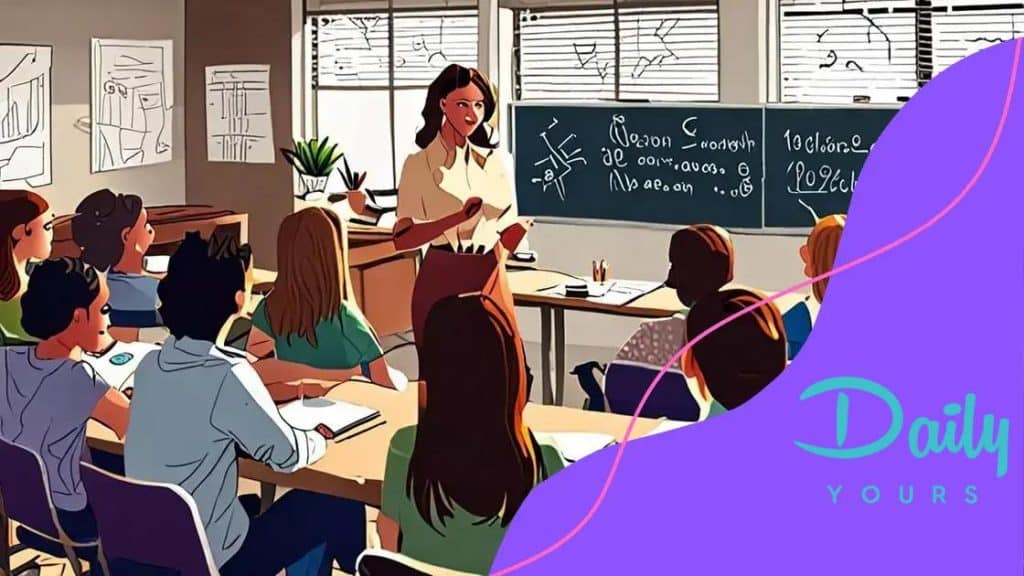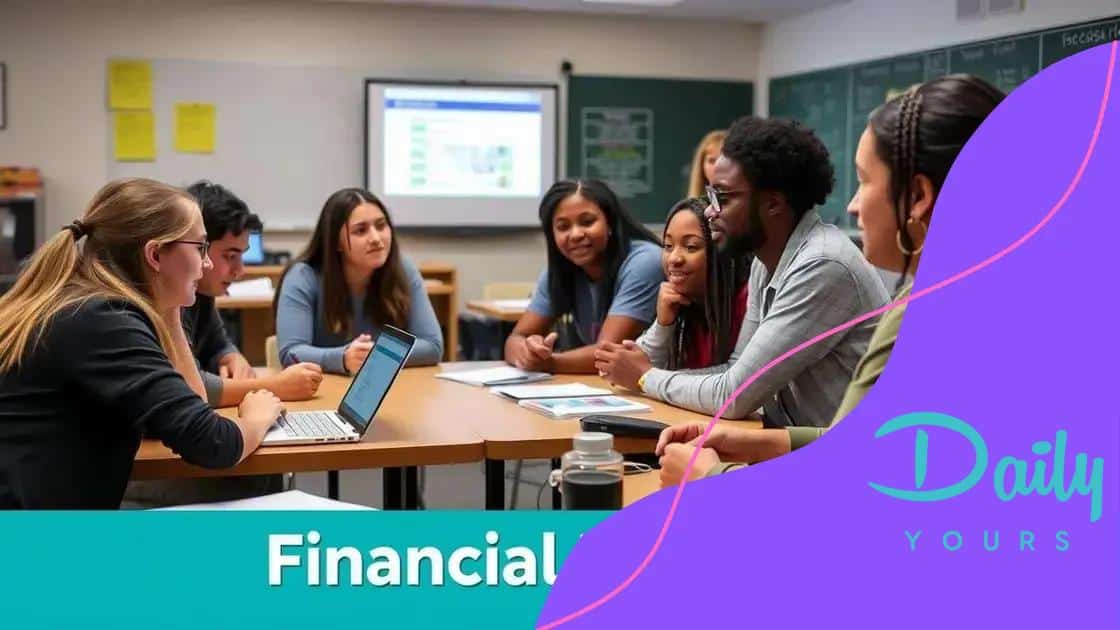Incorporating financial literacy into high school curricula

Anúncios
Incorporating financial literacy into high school curricula equips students with vital skills, such as budgeting and investing, preparing them for responsible money management and informed financial decisions throughout their lives.
Incorporating financial literacy into high school curricula is more than just a trend; it’s a necessity. Have you ever wondered how teaching students about money management could change their future?
Anúncios
Understanding the importance of financial literacy
Understanding the importance of financial literacy is crucial for students in high school. This knowledge equips them with essential skills that they will use throughout their lives. By grasping basic financial concepts, students can make informed decisions about their money.
Why is Financial Literacy Important?
In today’s world, where financial products are abundant, knowing how to manage money is vital. Financial literacy helps students develop a positive relationship with money, which considers savings, investments, and spending.
- Builds confidence in managing personal finances.
- Prepares students for real-world financial situations.
- Encourages responsible spending and saving habits.
Real-Life Applications
When students learn about topics like budgeting, investing, and credit, they can apply this knowledge in their daily lives. They start to see how financial decisions impact their futures. For example, understanding how to create a budget can help prevent debt and encourage savings.
Anúncios
Moreover, financial literacy empowers students to take control of their financial destiny. As they learn about tools such as bank accounts and credit scores, they become more aware of their financial situations. This awareness can lead to better choices in education and career paths.
In addition, it cultivates a sense of responsibility. Students who understand financial principles are more likely to consider long-term consequences when making decisions, leading to more sustainable choices.
Overall, integrating financial literacy into high school curricula is essential for preparing innovative and resilient young adults. By prioritizing this education, we equip students to navigate the complexities of the financial world confidently.
Key concepts to teach in high school
When teaching high school students about financial literacy, it’s essential to cover key concepts that provide a solid foundation. These concepts will help them manage their money wisely and prepare for future financial decisions. Topics such as budgeting, saving, investing, and understanding credit are fundamental.
Budgeting Basics
One of the first skills students should learn is how to create a budget. A budget helps individuals track their income and expenses, making it easier to plan for future purchases.
- Identify sources of income.
- List monthly expenses and categorize them.
- Set saving goals.
Understanding Saving
Saving is another crucial concept where students should learn about the importance of having an emergency fund. It’s vital to encourage students to set aside a portion of their earnings for unexpected expenses.
Additionally, students should understand the advantages of saving in a bank account. It helps in accumulating interest and keeps money safe from impulse spending. Encouraging young people to save can set the stage for their financial success.
The Basics of Investing
Introducing the idea of investing can be exciting for students. They should learn how investments can grow wealth over time. Understanding stocks, bonds, and mutual funds will prepare them for future financial opportunities.
Discussions around the stock market can make learning engaging. Students will find it appealing to connect classroom knowledge with real-world applications. This understanding can empower them to make informed investment decisions as they grow older.
Credit Awareness
Finally, understanding credit is crucial for high school students. They should learn what a credit score is and how it impacts their ability to borrow money. By grasping the basics of loans and credit cards, they’ll become more responsible borrowers.
It’s essential to teach students how to build a good credit history. Responsible use of credit cards can lead to better financial opportunities in the future, like lower interest rates on loans. Through these lessons, students will feel prepared to navigate their financial journeys confidently.
Engaging methods for delivering lessons

Engaging methods for delivering lessons in financial literacy can significantly enhance students’ understanding and retention. By using interactive and hands-on approaches, educators can foster an environment where students feel excited about learning. This not only keeps their interest but also encourages them to apply what they learn in real life.
Interactive Activities
One effective method is to incorporate interactive activities. Activities like simulations, role-playing, and gamification make learning fun and memorable. For instance, students can participate in budgeting games where they manage a fictional household budget.
- Role-play buying a car or renting an apartment.
- Simulate stock market investments with virtual money.
- Create group projects to plan financial goals.
Utilizing Technology
Technology can also play a vital role in lesson delivery. Utilizing apps and online resources allows students to access financial information easily. For example, budgeting apps can demonstrate how to track expenses and set savings goals effectively.
Another great option is to integrate videos and podcasts into lessons. These resources can provide relatable examples and stories that resonate with students. Engaging content helps solidify their understanding by connecting theory to practical situations.
Guest Speakers and Workshops
Inviting guest speakers, like financial experts or entrepreneurs, can greatly enrich the learning experience. Their real-world experiences provide valuable insights that textbooks may not cover. Workshops on specific topics, such as taxes or savings strategies, can also provide hands-on learning opportunities.
Students benefit from hearing diverse perspectives, which can inspire them to think critically about their financial decisions. This exposure is enriching and helps them visualize their future in various financial landscapes.
Peer Learning
Encouraging peer learning is another method to engage students. Group discussions or study circles can create a collaborative environment where they share ideas and help each other understand complex concepts. Working together fosters a more inclusive learning atmosphere.
Ultimately, the goal is to create dynamic, engaging lessons that stimulate interest in financial literacy. When students are actively involved in their learning, they are more likely to develop positive habits that will benefit them throughout their lives.
Real-life applications and projects
Real-life applications and projects are essential components of teaching financial literacy in high schools. These methods help students see the relevance of what they learn in the classroom. By engaging in practical activities, students can apply their knowledge, which enhances their understanding.
Personal Finance Projects
One effective approach is to have students create personal finance projects. These projects can involve budgeting for a real or hypothetical event, such as planning a trip or organizing a small event. Students can research costs, create a budget, and then compare their planned expenses to actual costs.
- Research costs for accommodations, transportation, and activities.
- Use budgeting software or spreadsheets to manage finances.
- Reflect on what they learned about money management.
Investment Simulations
Conducting investment simulations can also spark student interest. In these simulations, students can use virtual currency to invest in stocks. They can track their investments over time and learn the concepts of risk and return. This hands-on experience allows them to understand how the stock market works in a safe environment.
After participating in a simulation, students can discuss their strategies and what factors influenced their decisions. This encourages discussion and critical thinking about investing.
Community Service Projects
Engaging in community service projects with a financial twist can further enhance learning. For example, students can partner with local organizations to help teach financial literacy to younger students or adults. This not only reinforces their own knowledge but also provides a service to the community.
These projects help develop empathy and a sense of responsibility while also reinforcing the importance of financial skills. By teaching others, students solidify their understanding of fundamental concepts.
Creating a Business Plan
Encouraging students to create a business plan offers another strong learning opportunity. This project can help them understand concepts like marketing, budgeting, and forecasting. Students can develop a product or service idea, outline their target market, and project their potential earnings.
By learning how to create a business plan, students gain essential skills that are valuable in real-life situations. They also learn to think critically and creatively about financial opportunities.
Measuring the impact of financial education
Measuring the impact of financial education is crucial to understanding its effectiveness in high schools. By assessing how well students grasp financial concepts, educators can improve their teaching methods and curriculum.
Defining Key Metrics
To measure impact, it’s important to define key metrics. These could include improvements in students’ knowledge, attitudes towards saving and spending, and their ability to manage budgets.
- Pre-and post-assessments to evaluate knowledge gains.
- Surveys to gauge changes in attitudes towards money.
- Tracking students’ ability to create and follow a budget.
Using Surveys and Assessments
Surveys can be a great tool to understand students’ perceptions of financial literacy. By conducting surveys before and after a course, educators can see if students feel more confident in handling their finances. Additionally, assessments can provide quantitative data to analyze knowledge gains. These tools help align the curriculum with students’ needs and interests.
Tracking Long-Term Outcomes
Measuring immediate success is important, but so is tracking long-term outcomes. Looking at how financial education influences students as they transition to adulthood can provide valuable insights. Key indicators to monitor may include:
- The ability to save money consistently.
- How often they invest in stocks or other assets.
- Their credit scores and debt management over time.
Engaging with Alumni
One effective way to measure impact is to engage with alumni. Gathering feedback from former students about how the financial literacy lessons helped them in real-life situations can offer powerful evidence. Their experiences provide a personal perspective on the lasting effects of financial education.
Alumni can share stories about important financial decisions they made, which were influenced by what they learned in school. This real-world feedback can help schools refine their programs.
Overall Importance
Ultimately, measuring the impact of financial education is about ensuring students are well-equipped for their financial futures. By collecting data on students’ understanding, behavior, and long-term success, schools can create better programs that equip young people with essential skills.
FAQ – Frequently Asked Questions about Financial Literacy in High Schools
Why is financial literacy important for high school students?
Financial literacy is crucial for high school students as it equips them with essential skills to manage money effectively, make informed financial decisions, and prepare for their future.
What key concepts should be taught in financial education?
Students should learn about budgeting, saving, investing, and understanding credit to build a strong financial foundation for their adult lives.
How can schools measure the effectiveness of financial education programs?
Schools can measure effectiveness through pre-and post-assessments, surveys about students’ financial confidence, and tracking long-term outcomes like savings and credit scores.
What engaging methods can teachers use to deliver financial education?
Teachers can use interactive activities, technology tools, real-life projects, and guest speakers to make financial literacy lessons more engaging and relevant for students.





